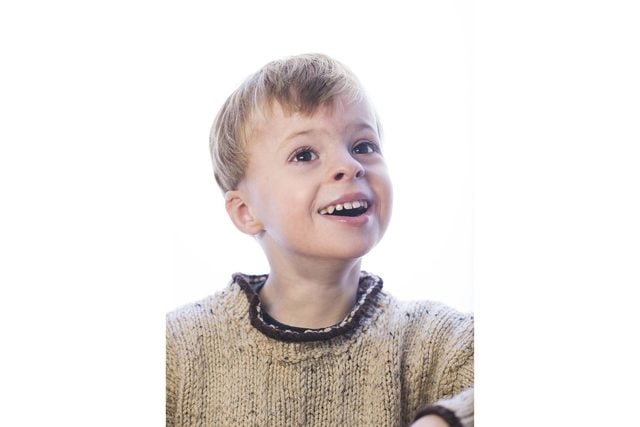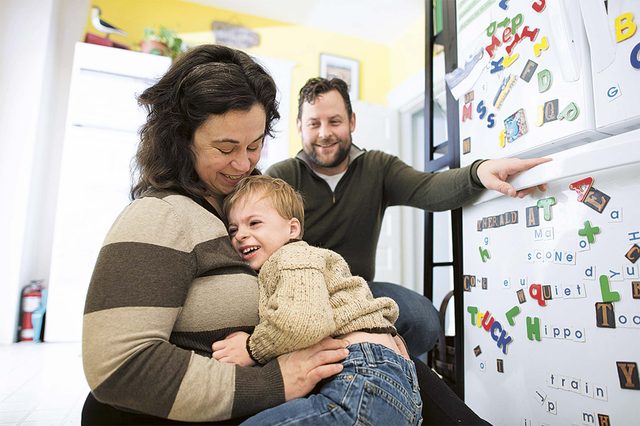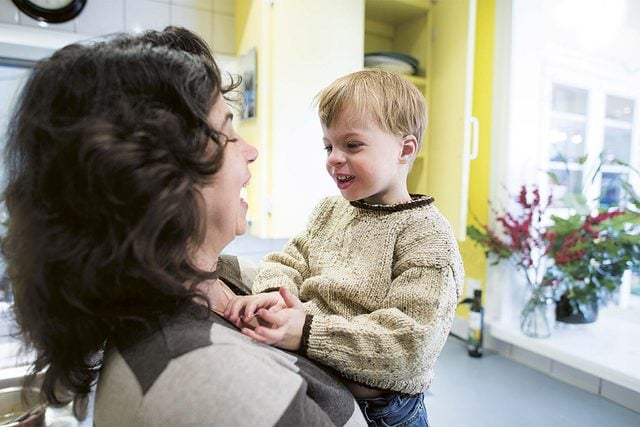Doctors Thought This Disabled Boy Would Never Speak. Boy, Did Alexander Turner Prove Them Wrong.
Updated: Nov. 04, 2022
Alexander was a strangely motionless and silent baby, and doctors knew of fewer than 100 cases like his in the world. Here, how his family's love and perseverance overcame a grim diagnosis.

For the first six months of Alexander’s life, I wanted to believe he might get well on his own. I would often lie down on the floor and make faces at him, trying to tease out a smile. Sometimes, after lots of effort, it worked. But mostly, my son was motionless and silent, his eyes focused on nothing in particular.
It was fall 2009, and my wife, Ashley, and I had only just moved into a new home in downtown Calgary, Alberta. We had a vivacious four-year-old daughter named Sloane, a grouchy Siamese cat, and an infant son who was a mystery. Alexander had been born hypotonic—floppy, basically—with an abdominal hernia, a heart murmur, strange folds on his ears, and a V-shaped birthmark in the center of his forehead. The geneticist assigned to us in intensive care, Micheil Innes, knew these were markers of a genetic disorder, but he couldn’t identify which one it was.
Even after Alexander was healthy enough to come home, he was undersized and underweight, hardly able to hold up his head. Amid the rush of feeding and diapers and getting Sloane to school, I could pretend he was just a little quiet and weak for his age. But the truth is, we often wondered if there was any awareness inside him at all.
The first tentative answer arrived on a dark afternoon in December. We were called to a small room at the Alberta Children’s Hospital, where Innes explained that a piece of our son’s genetic coding simply wasn’t there. He showed us Alexander’s lab results: rows of striped squiggles like some ancient alphabet and a red dot indicating the location of the missing material, near the end of the “q” branch of the ninth pair of chromosomes. The precise spot, in technical terms, was 9q34.3.
[pullquote] Innes believed there were fewer than 100 verified diagnoses worldwide at the time. [/pullquote]
Innes then handed us a pamphlet that had been printed from a website. The document explained that “9q34.3 subtelomeric deletion syndrome” was usually an uninherited, spontaneous mutation, likely occurring at conception. The condition is also called Kleefstra syndrome, after a Dutch researcher who studies it. Innes believed there were fewer than 100 verified diagnoses worldwide at the time. Alexander’s developmental problems were born of a single cause—the tiniest of wounds, duplicated in every single cell in his body, forever. Because there were so few cases, the pamphlet provided anecdotes rather than a prognosis: a series of expected obstacles—to speech, mobility, learning—that our son might overcome, if lucky, after a lifetime of hard work.

Ashley and I drove home from the hospital in devastated silence, as if some vital swatch of our family’s fabric had been ripped away. We were terrified that our mute child would never walk or talk, let alone run across a playground or march up the aisle at his wedding. Later, as I watched Alexander in bed, I was too numb even to cry. I started to indulge in wishful thinking. Maybe he’ll simply catch up to his peers, I thought. Maybe someone will figure out how to fix this. I was convinced, in any case, that I couldn’t.
[pullquote] Ashley and I drove home from the hospital in devastated silence, as if some vital swatch of our family’s fabric had been ripped away. [/pullquote]
A few days after meeting the geneticist, we were having dinner when Sloane left her seat and skipped to her brother in his high chair at the other end of the table. We hadn’t discussed Alexander’s diagnosis with her, but Sloane’s internal radar for her parents’ moods had always been impeccable, and we were both far too shaken to hide it very well. My wife, usually a boisterous, no-holds-barred play fighter, had already stopped the roughhousing as the house filled with a formless, boundless anxiety.
Sloane set herself up behind Alexander, hands clutching either side of his chair, and flung herself from one side of his head to the other. With each swing, she bellowed, “Hello, Mr. Chubby Cheeks!” Alexander began to swing his head back and forth in time with her. His face erupted in a gap-mouthed grin. And then, for the first time in his life, Alexander laughed. Hard. A sudden gurgling, exuberant laugh. And then we all did.
Somewhere on the other side of the diagnosis was a boy who could feel joy. It was our job to find him.
We began where almost all parents with a special-needs child begin: monthly visits to an overworked early intervention clinic that recommended rudimentary physical therapy—exercises to encourage rolling over and sitting up, for example. The workouts seemed arbitrary and totally out of proportion to Alexander’s need, like Band-Aids on broken limbs.
My wife pushed the therapists at the clinic for better ways to address Alexander’s disorder. They were kind and competent, but Kleefstra syndrome was a question mark for them too. The message was to wait and see, to react once Alexander’s symptoms were clearer. Had we acquiesced, the “intensive” part of my son’s therapy would’ve started around the age of three, at the earliest.
Ashley has never accepted the default position on anything, and when it came to her fear of her son’s diminished prospects, she was relentless. She used her background as a research editor and radio producer to dig deeper. Books on disability and the brain piled up on her bedside table. One title was Glenn Doman’s What to Do About Your Brain-Injured Child. Doman—who died in 2013, at 93—was the founder of the Institutes for the Achievement of Human Potential, an unconventional teaching institute in Philadelphia. Using its methods, neurologically impaired kids learn not only to walk and talk but to read and count—often well ahead of unimpaired peers. Ashley had been begging me to look at Alexander’s condition as a crisis that, though it could never be eradicated, could be treated. Here, finally, was corroborating evidence.
As a physical therapist in the 1940s, Doman was frustrated by the high failure rate of the techniques used on stroke victims and, later, children with disabilities. He and his associates at the clinic developed a new approach founded on the theory that the brain can grow and change through use—today called neuroplasticity. His clinic amassed evidence, case by case, that with enough hard work, kids like Alexander often exceeded every limitation that had been placed on them.
At that point, the simple exercises at the clinic inspired nothing but frustration from Alexander. But following specifications in a book by Doman’s son, Douglas, my father and I built a “crawling track” in our living room. It was a simple ramp with low sides made of heavy plywood, like a jungle gym slide, wrapped in padding and turquoise vinyl. Following the instructions, we propped the track at an incline steep enough that Alexander’s slightest wiggle would result in movement. Then, against any number of parental instincts, we placed my son at the top. He was seven months old and had never willfully moved an inch in his life. He howled in protest, squirmed in defiance—and the motion sent him skidding down the track.
Within a week, he was propelling himself, angry at first, but eventually with resolve and even joy. We reduced the incline as he improved, until it was lying flat. A few months later, he crawled right off the end of it. And then he kept right on going.
We signed up for the next available introductory session at Glenn Doman’s clinic, now directed by his daughter-in-law, Rosalind. Alexander was the first diagnosed Kleefstra kid the clinic would ever treat.

In Philadelphia the following April, when Alexander was just 11 months old, we found ourselves surrounded by three dozen parents who had come from as far away as Belarus, Singapore, and India. In a week of all-day lectures, our expectations for Alexander—and for our role in his therapy—were turned upside down. The clinic’s program was wildly ambitious and nearly impossible to implement fully. It involved almost constant, regimented stimulation, physical activity, and intellectual engagement: daily crawling distance targets, reading and math exercises, workouts aimed at improving breathing and coordination—all of it done by parents themselves. As Rosalind told us at the time, “There are lots of reasonable programs out there. Trouble is, they don’t work very well.”
When we returned home the next week, we reorganized the main floor of our house around Alexander’s therapy. We filled our living room with mats and flash cards emblazoned with words and dots for counting. As part of Alexander’s physical therapy, we installed an elaborate “monkey bars” ladder apparatus. (Learning to walk while alternating hands on the rungs would help train Alexander’s brain in “cross-pattern” movement, and the raised arms would encourage good posture.) Our son’s diet was stripped of known allergens and inflammatories to eliminate any possible nutritional impediments to his development. His daily regimen looked like something prescribed to an Olympic athlete.
The standard approach for a developmentally delayed person is not this ambitious. But we didn’t want to wait until after our child’s malleable brain had stiffened into adulthood. Ashley and I now had the tools to make the most of Alexander’s crucial early years. We intended to use them all.
[pullquote] His daily regimen looked like something prescribed to an Olympic athlete. [/pullquote]
Ashley threw herself into running Alexander’s therapy program full-time, and my daily routine as a work-from-home freelancer soon involved at least as much duty as a therapy assistant. The stress was enormous, and our debt grew whenever we sacrificed more work time for Alexander’s sessions. For my wife, the manager of our ersatz team, administering the multiple programs meant constructing a self-made cage. Once, our professional lives had involved extended research trips, and now whole weeks could pass without either of us leaving the house except to ferry our daughter to and from school.
Still, we agreed that the strain on our family was far better than the despair of not knowing what to do. We believed, most of the time, that there was a smart little boy straining to emerge from those flapping, disorganized limbs. Alexander’s program required a platoon of volunteer helpers, which meant most of our block knew all about his condition. The spring after he turned three, when he started to walk up and down the street on his own, his first trips were victory laps to cheering neighbors.
We would have to wait another year for proof that the reading and math exercises were sinking in. Day in and day out, we dutifully held up flash cards containing words and numbers, sentences and equations. But how could we know for sure how much of it was working when Alexander could speak only in fragments and monosyllables? Incontrovertible evidence came one day when we were in the car, about to pull out of a parking lot. Ashley was listing off rhyming words for Alexander to attempt to repeat. “Car,” she recited. Alexander repeated it.
Then they ran through far, bar, star.
Ashley paused, thinking the game was over. From the backseat came a thin, cheerful voice: “Guitar!” An unprompted, two-syllable rhyme. Our explosive cheer was so loud, it startled Alexander almost to tears. The kid could talk—and rhyme! Every agonizing day of his therapy had been worth it for that marvelous rhyme.
Alexander recently turned seven, and we no longer have reason to doubt his ability to learn. His daily life is an inventory of things he wasn’t expected to do—possibly ever, certainly not by now. He can tell you his name and address. He’ll ask you to draw a cement truck on his whiteboard, then spell the letters with glee as you write them out. At the grocery store, he counts off the aisles from the signs overhead, calling, “Aisle five!” with particular delight. Then we stand in beloved aisle five to wait for the automated checkout kiosks. “Commpooter!” Alexander announces as I sweep our groceries over the sensor, raising his arms in excitement. Gazing out from beneath a tussle of golden hair, his deep brown eyes are magnetic—they never fail to tease a smile from the checkout attendant.
Last fall, just a year behind schedule, Alexander started kindergarten in a standard classroom. Whatever his limitations are, he is nowhere near them yet. He might never be completely self-sufficient. But I believe if he winds up anywhere near such a state, it will be because, against the advice of many experts, we maximized every moment during his early years, when his brain was most able to reorganize itself to compensate for the tiny missing sliver of gene in every cell. I want Alexander to be seen as a model of how early intervention should be done: all day, every day, as much as a distressed family can possibly cram in, from the moment anyone suspects anything is wrong.
[pullquote] He might never be completely self-sufficient. But I believe if he winds up anywhere near such a state, it will be because, against the advice of many experts, we maximized every moment during his early years. [/pullquote]
This, I hope, is my son’s lesson for all of us: Our approach to special-needs kids is completely upside down. We’ve only just left the dark ages when it comes to our understanding of how the human brain works. The potential waiting there is an enormous untapped resource. And, as Alexander has proved already, many of the limits we long believed were impossible to overcome fall away in the face of the right kind of hard work.